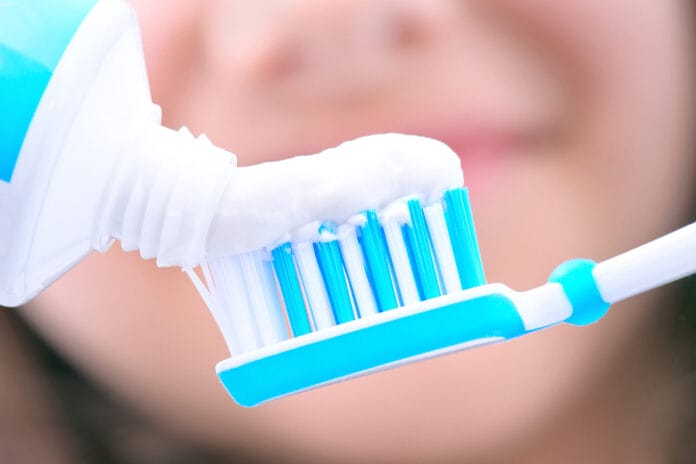A common concern among patients during a dental hygiene appointment is the use of fluoride. Whether it is an applied topical fluoride application at the appointment or the use of fluoride toothpaste at home, some patients don’t prefer it. However, fluoride is recommended by the dental professional to reduce caries production and to promote remineralization of a compromised tooth surface.
Recently, I was introduced to hydroxyapatite toothpaste as an alternative to fluoride for caries prevention and remineralization. Therefore, this article will compare over-the-counter hydroxyapatite toothpaste versus fluoride toothpaste.
Fluoride Toothpaste
Fluoride is “an inorganic, monatomic anion of fluorine, with the chemical formula F− (also written [F]−), whose salts are typically white or colorless.”1 Also, “fluoride ions occur on earth in several minerals, particularly fluorite, but are present only in trace quantities in bodies of water in nature.”1 Fluoride is a combination of the fluorine ion and sodium combined.
Fluoride can be administered topically or systemically for dental caries prevention. An example of systemic fluoride would consist of the consumption of water that has a naturally occurring fluoride level or has been treated with fluoride. Another example is a prescription fluoride tablet that is consumed at an early age to prevent and strengthen the teeth during childhood development. A topical application consists of dentifrices such as mouth rinse and toothpaste, as well as fluoride varnish, gels, and prescription rinses that are directly applied to the teeth regardless of age and developmental stages.
Fluoride acts as a protector and helps remineralize teeth from the bacterial by-products that cause caries. The tooth enamel is made up of calcium and phosphate. However, the carbohydrates in certain foods we consume are also ingested by the bacteria in the mouth and are converted into acid. The acidic by-product of bacteria after sugar ingestion will essentially break down the calcium and phosphate of the enamel tooth surface, thus causing the enamel to be compromised, and caries are formed.2
The use of fluoride is beneficial because the fluoride will join forces with the phosphate and calcium of the tooth surface, which creates a barrier that is difficult for the acid to break down and penetrate. This collaboration of fluoride, calcium, and phosphate is also referred to as “fluorapatite.”
One of the main reasons some dental patients are partial to non-fluoride toothpastes and dental products is the possible toxicity of fluoride. Current internet findings state that fluoride at higher than recommended dosages can interfere with the development of the enamel structure, also known as dental fluorosis. In addition, the International Academy of Oral Medicine and Toxicology, a biological dental organization, states that “fluoride is also known to impact the cardiovascular, central nervous, digestive, endocrine, immune, integumentary, renal, and respiratory systems, and exposure to fluoride has been linked to Alzheimer’s disease, cancer, diabetes, heart disease, infertility, and many other adverse health outcomes.”3
According to the American Dental Association (ADA), fluoride is a crucial component in the fight against dental caries. The ADA states, “When used as directed or within the context of community water fluoridation programs, fluoride is a safe and effective agent that can be used to prevent and control dental caries.”4
According to ADA guidelines, the recommended and safe dosage for water fluoridation is “0.7 parts fluoride per million.”4 In addition, toothpaste must contain fluoride to receive the ADA seal. In reference to fluoride content for toothpaste, the ADA recommends “at least 1000ppm of fluoride with no sugar additives.”4
Hydroxyapatite Toothpaste
Hydroxyapatite is the main component of enamel and makes up 60% to 70% of the inorganic compounds found in tooth enamel.5 Hydroxyapatite has “significant remineralization effects on initial enamel loss.”5 In addition, it has some unique properties such as “the ability to chemically bond to bone,” but it does “not induce toxicity or inflammation.”5 It can also “stimulate bone growth through direct action on osteoblasts.”5
Hydroxyapatite does not only bond to proteins but also to plaque and bacteria when introduced through toothpaste. The remineralization property of hydroxyapatite is achieved through the size of its nanoparticles that increase the surface area of the enamel, thus allowing proteins to bond, which, in return, act as a filler.5
Hydroxyapatite was first used by the National Aeronautics and Space Administration (NASA). NASA produced synthetic hydroxyapatite to aid in repairing the astronauts’ “loss of minerals in teeth and bone due to the lack of gravity.”5
In the 1970s, the Japanese-owned Sangi Co., Ltd. purchased the rights of the synthetic hydroxyapatite and launched the first known hydroxyapatite toothpaste in 1978. Beginning in 2006, the hydroxyapatite toothpaste was marketed to replace fluoride for its remineralization properties in Europe.5
Hydroxyapatite Versus Fluoride
Though a small study, in 2019, a study was conducted using two toothpastes ─ 10% hydroxyapatite toothpaste and 500ppm fluoride toothpaste. The study included 30 test subjects with one sound tooth and one caries-induced lesion tooth. The subjects wore an intraoral appliance that contained one of the two toothpastes over 14 days.6
Importantly, the results of the study indicated that the baseline reading and post-test readings showed significant remineralization and lesion depth, whereas there was no “statistically significant difference in remineralization and lesion depth reduction between the two toothpastes” when compared to one another.6 However, the 10% hydroxyapatite toothpaste did “produce a more homogeneous lesion remineralization” than the 500ppm fluoride toothpaste.6 Therefore, based on the indicated study, the hydroxyapatite and fluoride toothpaste was equal in efficiency for remineralization and preventing demineralization.
As science advances, there becomes an increase of products on the market that can appeal to any consumer. Based on the recent study, the use of a hydroxyapatite toothpaste seems to be an effective alternative for the anti-fluoride patient. Dental professionals can sleep well at night knowing that we have educated and promoted a safe and effective vehicle for remineralization and the prevention of demineralization for our patients.
Before you leave, check out the Today’s RDH self-study CE courses. All courses are peer-reviewed and non-sponsored to focus solely on high-quality education. Click here now.
Listen to the Today’s RDH Dental Hygiene Podcast Below:
References
- Fluoride. (n.d.) Wikipedia. Retrieved from https://en.wikipedia.org/wiki/Fluoride
- The Superhero that Lives inside. (n.d.) American Dental Association. Retrieved from https://www.mouthhealthy.org/en/fluoride-superhero
- Sources of Fluoride Toxicity and Effects. (n.d.) International Academy of Oral Medicine and Toxicity. Retrieved from https://iaomt.org/resources/fluoride-facts/fluoride-toxicity-exposure-effects/
- Fluoride: Topical and Systemic Supplements. (n.d.) American Dental Association. Retrieved from: https://www.ada.org/resources/research/science-and-research-institute/oral-health-topics/fluoride-topical-and-systemic-supplements
- Pepla, E., Kostantinos Besharat, L., Palaia, G., et al. Nano-hydroxyapatite and Its Applications in Preventive and Regenerative Dentistry: A Review of Literature. Ann Stomatol (Roma). July-Sep 2014; 5(3): 108-114. Retrieved from https://www.ncbi.nlm.nih.gov/pmc/articles/PMC4252862/
- Amaechi, B.T., AbdulAzees, P.A., Alshareif , D.O., et al. Comparative Efficacy of a Hydroxyapatite and a Fluoride Toothpaste for Prevention and Remineralization of Dental Caries in Children. US National Library of Medicine. 2019 Dec 9; 5:18. doi: 10.1038/s41405-019-0026-8. Retrieved from https://pubmed.ncbi.nlm.nih.gov/31839988/












